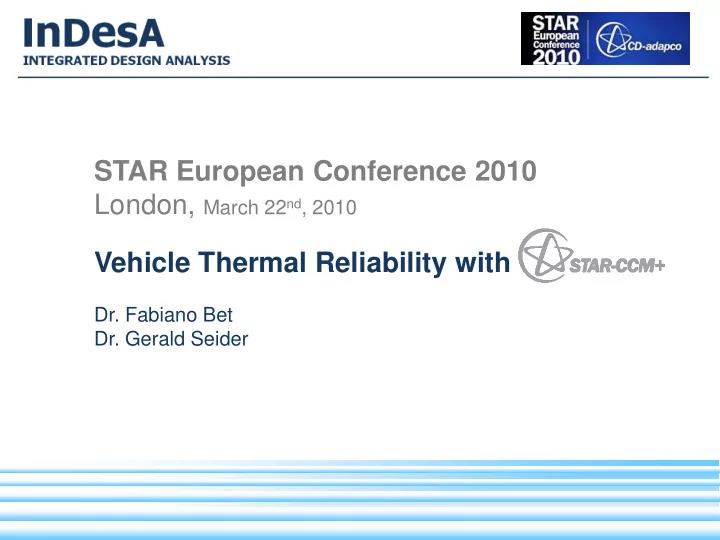

Vehicle Thermal Reliability STAR European Conference 2010 London, March 22 nd , 2010 Vehicle Thermal Reliability with Dr. Fabiano Bet Dr. Gerald Seider STAR Konferenz 2009, Berlin, page 1
Vehicle Thermal Reliability Vehicle Thermal Management Thermal Sources: Engine Exhaust System Alternator, etc. Heat Release: Heat Exchangers Convection Radiation STAR Konferenz 2009, Berlin, page 2
Vehicle Thermal Reliability Design and Verification of Thermal Reliabilty Concept Prototypes/Testing Thermal Verification Start of Production development process Verification of thermal reliability is carried out late in the development process. Engine’s safety applications for combustion must be released, which guarantee secure operation of the engine in the earlier development stages. Thermal load imposed by the exhaust system to the underhood environment will become more critical as the engine matures. Underhood thermal reliability is very dependent on the proper location of air ducting components, seals and heat shields which as are settled late in the developing process. Therefore a simulation methodology is needed which can assess thermal reliability at a much earlier stage of the development process. STAR Konferenz 2009, Berlin, page 3
Vehicle Thermal Reliability Engine Thermal Analysis - „State of the Art“ Cooling Distortion Stress Endurance Thermal Management STAR Konferenz 2009, Berlin, page 4
Vehicle Thermal Reliability Analysis of Coolant Circuits - „State of the Art“ Velocity Magnitude Coolant Circuit: Water Pump and Thermostat Radiator (high & low temp. pass) Oil-Water Heat Exchanger Cabin Heater Degas Bottle Engine Waterjacket Simulation decoupled from thermal analysis. constant temperature of coolant. analysis of volume flow rates analysis of pressure losses in components verification/Input data for 1D system analysis STAR Konferenz 2009, Berlin, page 5
Vehicle Thermal Reliability Analysis of Engine Oil Supply - „State of the Art“ simulation decoupled from thermal analysis. fluid properties temperature dependent. analysis of volume flow rates (e.g. bypass) analysis of pressure losses in components verification/Input data for 1D system analysis Oil supply with heat exhangers (pressure side): Thermostat and Filter Oil Main Gallery Crankcase Oil/Air Heat Exchangers STAR Konferenz 2009, Berlin, page 6
Vehicle Thermal Reliability Underhood Analysis - „State of the Art“ simulation includes heat exchanger package with heat transfer fluid properties temperature dependent. analysis of flow rates through heat exchangers and front end analysis of heat transfer in heat exchangers verification/Input data for 1D system analysis STAR Konferenz 2009, Berlin, page 7
Vehicle Thermal Reliability Coupled Flow & Thermal Analysis coupled flow and thermal analysis 3D Analysis of the entire vehicle Flow Analysis: with: Underhood Convection Coolant Circuit Conduction Engine Oil Supply Radiation Heat Storage Thermal Analysis: Underhood goal: Core Engine 3D 3D Exhaust System Simulation and thermal Star CCM+ Starter/Alternator analysis of a car cooling down after high speed cruise (thermal soak). 1D Backbone (GT-SUITE) Challenge: 1. Handling of CFD/CHT Mega Simulation Models 2. Providing of Synchonized Sub-Models and Boundary Conditions STAR Konferenz 2009, Berlin, page 8
Vehicle Thermal Reliability Thermal Coupling of Simulation Models Oil Supply (pressure side) Vehicle (U-hood) Coolant Circuit Assembled Model Exhaust System Engine Structure (CHT) STAR Konferenz 2009, Berlin, page 9
Vehicle Thermal Reliability Assembling of Simulation Models Grade of Detail: Coolant Circuit Fan and Shroud Oil Supply Crankshaft and Cam Drive Crancase (Mg) with Al-Insert Cylinder Head and Cover Oil Pan Transmission Case STAR Konferenz 2009, Berlin, page 10
Vehicle Thermal Reliability Coupled Flow & Thermal Analysis total pressure and velocity fully coupled thermal analysis fluid/material properties temperature dependent analysis of flow rates through heat exchangers and front end inlets thermal interaction of all fluids and components total pressure STAR Konferenz 2009, Berlin, page 11
Vehicle Thermal Reliability Coupled Flow & Thermal Analysis temperature underbody Simultanious Simulation of: Aerodynamics Cooling and Temperature Fields Radiation total pressure velocity STAR Konferenz 2009, Berlin, page 12
Vehicle Thermal Reliability Coupled Flow & Thermal Analysis cut through thermostat engine thermal analysis Coupled Thermal Analysis: thermal laod e.g. from 1D combustion simulation (GT-POWER) conduction through engine structure convective transport through coolant heat release through heat exchangers (dual-stream) convective transport through engine oil STAR Konferenz 2009, Berlin, page 13
Vehicle Thermal Reliability Coupled Flow & Thermal Analysis flow though exhaust system (cold end) Coupled Thermal Flow and Thermal Analysis of Exhaust System: mass flow rate and temperature from 1D combustion simulation (GT-POWER) conduction through walls; partial insulation temperature fields and heat release through radiation addition of heat sources in catalysts steady flow through exhaust manifold flow through muffleer STAR Konferenz 2009, Berlin, page 14
Vehicle Thermal Reliability Coupled Flow & Thermal Analysis cut view cut view cut view Temperature Distribution STAR Konferenz 2009, Berlin, page 15
Vehicle Thermal Reliability Thermal Soak Analysis temperature ditribution t = 0 s t = 572 s temperature iso-surfaces STAR Konferenz 2009, Berlin, page 16
Vehicle Thermal Reliability Thermal Soak Analysis Exhaust exh. manifold 1-3 exh. manifold 4-6 temperature [°C] wheel house; mean Value heat flux [W] wheel house; max value total heat flux radiation time [s] time [s] T= 572 s T=0 s STAR Konferenz 2009, Berlin, page 17
Vehicle Thermal Reliability Thank you for your attention ! STAR Konferenz 2009, Berlin, page 18
Recommend
More recommend